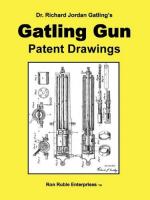|
This section contains 289 words (approx. 1 page at 300 words per page) |
World of Invention on Richard Jordan Gatling
Born in Hertford County, North Carolina, Gatling showed signs of creativity even as a youngster. He helped his father, a plantation owner and inventor, develop machines for sowing and thinning cotton. In 1839 Gatling invented a screw propeller for ships and went on to develop agricultural machines, such as a hemp-breaking device and a steam plow.
When the Civil War began in 1861, Gatling focused his efforts on armaments. In 1862 he invented the weapon that has bore his name ever since, the Gatling gun. Considered the first practical machine gun, the Gatling gun was capable of firing 250 shots per minute. It consisted of ten breach-loading rifle barrels, cranked by hand, that rotated around a central axis. Each individual rifle barrel was loaded by gravity feed and fired while the entire assembly evolved. Cartridges were automatically ejected as the other barrels fired. It was operated by two persons: one who fed the ammunition that entered from the top, and the other who turned the crank that rotated the barrels. At first, the Union Army was uninterested in Gatling's invention, but General Benjamin Butler (1818-1893) eventually bought several Gatling guns for one of his final campaigns. They worked so well on the battlefield that the government finally agreed to adopt them in 1866, but by then the war was over.
After the war, Gatling continued to improve his gun. Eventually it was capable of firing 1,200 shots per minute at all degrees of elevation and depression. Gatling's gun was used all over the world, and remained in the U.S. military arsenal until 1911. Gatling remained active in other areas of invention: he worked on a new method for casting cannons, built a motorized plow and invented a new alloy of steel and aluminum.
|
This section contains 289 words (approx. 1 page at 300 words per page) |


